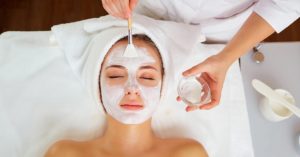The Truth about Skin Care Products
- Posted on: Jul 8 2019
We have all done it…stood in front of the ‘lotions and potions’ counter at various retail outlets (and now online stores) and tried to choose from the myriad of face creams available. We have also stockpiled products in our bathroom cupboards that ‘didn’t work’ or were too harsh.
It is estimated that in 2018 over $200 billion was spent globally on skincare products. I would like to demystify some skincare topics so that you don’t waste any of your money on products that don’t work well.
Most people are in search of products that will:
1) Protect skin from the sun and environmental pollutants
2) Ward off / reduce the lines and pigment that didn’t seem to be there 5 years ago
3) Not cause further environmental damage (i.e. coral reefs and chemical sunscreens)
To offer my thoughts on what is essential and what really works based on medical studies, I will respond below to the most common questions I hear in my practice as the physician director of Viva Medical Aesthetics here in the Cowichan Valley.
“I use a quality expensive cleanser and moisturizer so why do I still have lines and sun damage?”
Quality and expensive are not necessarily the same. Expensive products do not necessarily contain quality ingredients. To make informed decisions about your products, make sure they have an ingredient list. Check that the ingredients are proven useful and that the product is paraben-free. Beware of expensive ‘peptide containing’ creams. There is no medical evidence that these work.
Make sure that your cleanser is PH balanced and suitable for your skin type. If in doubt, always choose a gentle product. I see a lot of damage from harsh scrubs.
Moisturizers alone will not treat wrinkles and fine line. At best, they will hydrate your skin. As you age, levels of Hyaluronic acid (which binds water) and ceramides (which contribute to the waxy lipids in the top layer) diminish and leave your skin vulnerable to damage. Some moisturizers contain these products and they can be beneficial for hydration.
“I use a moisturizer that contains an SPF 15. Is that enough?”
SPF is a relative measure of how long a sunscreen will protect you from UVB (burning) rays. SPF 15 blocks 93% of UVB rays, SPF blocks 97%, and 50 blocks 98%. The difference between 30 and 50 is a mere 1%. You should choose a sunscreen with SPF 30 to 50 and use it every day including during the winter. Sunscreen should be reapplied every 2 hours.
To protect against UVA (ageing) rays, the product should contain Zinc Oxide 10 – 15%. Zinc will also block UVB rays. My preference is to use a pure Zinc containing cream in the morning and a Zinc powder in the afternoon. Zinc powders are great for children too as they are so pure and easy to apply.
“Aside from zinc-containing sunblock, what do I need to use daily to care for my skin?”
Pharmaceutical grade Vitamin C topically is the new “go-to” for effective treatment of and protection from skin damage. Vitamin C is amazing at protecting your skin from environmental pollution as well as treating and reversing some signs of sun damage. It is excellent for sensitive rosacea type skin as well. Studies are showing that 15% Vitamin C combined with Vitamin E and Ferulic Acid increases photoprotection. Vitamin C can be applied as a serum (this liquid consistency offers the best absorption), as a cream, or as a powder mixed into your moisturizer. Vitamin C, E, and Ferulic Acid can be applied twice a day but you must also use sunblock over the top.
Retinoids remain the gold standard for topical anti-ageing products. They stimulate collagen, improve pigmentation, thicken thinning skin, and improve skin texture. Low percentage retinoids can be used by most people. The key is to start low and slowly increase the percentage as your skin becomes conditioned. You just use retinoids at night but the use of a good sunblock in the day is essential since retinoids make your skin more sensitive to the sun. Retinol is available as a prescription (always ask for the lowest dose if just starting out) or as microencapsulated serums. Some anti-ageing creams claim they have retinol in them. Be careful to check the dosage to make sure there is enough to make a difference. I favour a stand-alone retinol serum or cream.
“I do not want a complicated regime.”
Neither do I, so here are the effective, simple steps that I can manage every day:
1) Morning: Cleanser, Vitamin C (plus E and Ferulic Acid if applicable), moisturizer, and sunblock.
2) Midday: Reapply sunblock with a mineral powder.
3) Bedtime: Cleanser, retinoid, Vitamin C, moisturizer.
The order is important. Treatment creams go closest to your skin. Sunblock goes closest to the sun.
Positive ageing may look different for each of us.
I LOVE that, as I get older, I am able to choose how I want my ageing to look. For me, it is loving my partner, children, grandchildren and friends, supporting our local community, and taking care of my body. To me, this includes my skin and I want to do that in an informed way.
By Dr. Lyn Pascoe
Tagged with: Dr. Pascoe, Ferulic Acid, sunblock, Vitamin C, Vitamin E
Posted in: Skin Care



